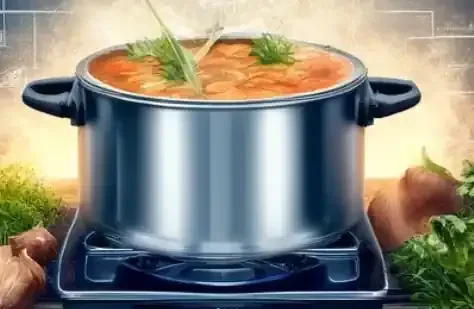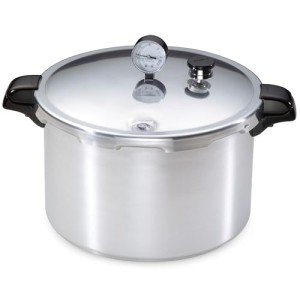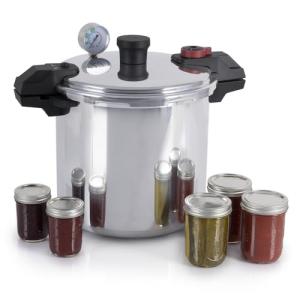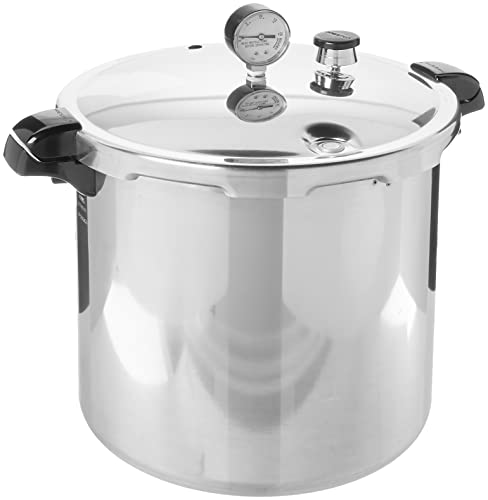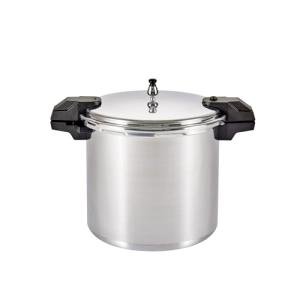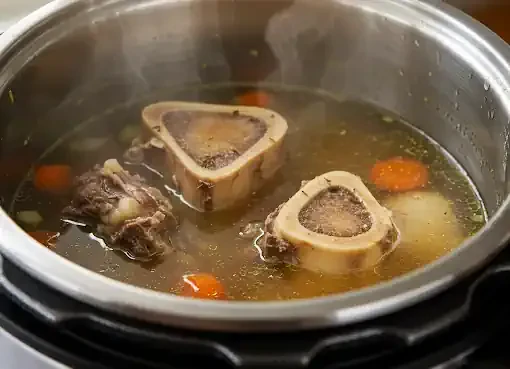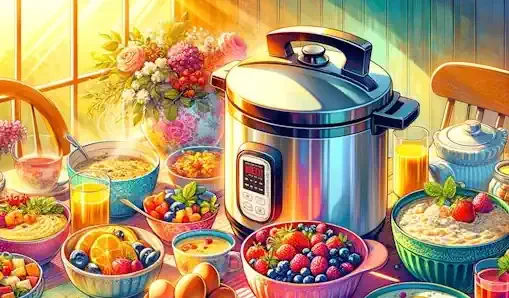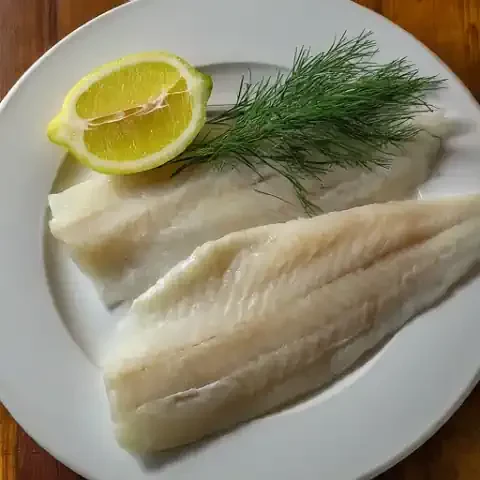Embrace the Power of the 10-Quart Pressure Cooker
A symphony of flavors, aromas, and tender textures awaits you in the realm of pressure cooking. And when you wield a 10-quart pressure cooker, you unlock a world of culinary possibilities, where meals that once took hours simmer into deliciousness in a fraction of the time. But what sets this size apart, and why should you consider adding one to your kitchen arsenal? Let's dive in.
What Makes the 10-Quart Size Special?
Imagine effortlessly preparing a hearty pot roast for a family gathering or a week's worth of nutritious soups and stews in a single cooking session. The 10-quart pressure cooker's generous capacity makes it the perfect choice for:
Large Families and Gatherings: Easily feed 8-10 people with ample leftovers.
Meal Prepping: Batch cook ingredients for multiple meals in one go.
Canning and Preserving: Process jars of homemade goodness efficiently.
Not only does it offer ample space, but the 10-quart size also strikes a balance between versatility and practicality. It's big enough to handle large cuts of meat or batches of beans, yet still manageable to store and lift.
Benefits of Pressure Cooking for Busy Lives
In our fast-paced lives, time is a precious commodity. Pressure cooking offers a lifeline for those seeking to prepare delicious, home-cooked meals without sacrificing hours in the kitchen. Here's how a 10-quart pressure cooker can revolutionize your cooking routine:
Unmatched Speed: Pressure cooking harnesses steam to create a super-heated environment, significantly reducing cooking times. Think fall-off-the-bone ribs in under an hour or creamy risotto in minutes.
Enhanced Flavor and Nutrients: By sealing in steam, pressure cooking intensifies flavors and helps retain more vitamins and minerals compared to traditional cooking methods.
Energy Efficiency: Pressure cookers use less energy than conventional ovens or stovetops, saving you money on your utility bills.
Versatility: From meats and stews to grains, beans, and even desserts, the possibilities are endless with a pressure cooker.
Why This Guide Is Your Go-To Resource
Embarking on your pressure-cooking journey can be both exciting and daunting. This comprehensive guide is designed to be your trusted companion every step of the way. You'll find:
In-Depth Explanations: Demystifying the science behind pressure cooking and providing clear instructions for safe and successful use.
Expert Tips and Tricks: Uncovering the secrets to achieving consistently delicious results with your 10-quart pressure cooker.
Mouthwatering Recipes: Curated collection of recipes specifically tailored for the 10-quart size, showcasing the versatility of this culinary powerhouse.
Buying Guides and Reviews: Helping you choose the perfect 10-quart pressure cooker to suit your needs and budget.
Ready to explore the world of faster, flavorful meals? Let's continue this culinary adventure.
Understanding Your 10-Quart Pressure Cooker
Before you embark on your culinary adventures, let's get acquainted with the heart of the operation: your 10-quart pressure cooker. Understanding its anatomy, the different types available, and the essential safety precautions will empower you to cook with confidence and achieve consistently delicious results.
Anatomy of a Pressure Cooker: Essential Parts
Every pressure cooker, regardless of brand or model, shares a few key components that work in harmony to create the magic of pressure cooking:
Pot: The sturdy container that holds your ingredients, typically made of stainless steel or aluminum.
Lid: The heavy, locking lid that seals the pot to create the pressurized environment.
Gasket (Sealing Ring): A rubber or silicone ring that fits into a groove on the lid, creating an airtight seal.
Pressure Regulator: A weight or valve that controls the pressure inside the cooker by releasing steam.
Safety Valve: An additional release mechanism that activates if the pressure regulator fails, preventing overpressure.
Handles: Heat-resistant handles for safe lifting and carrying.
Locking Mechanism: A system that secures the lid to the pot, ensuring a tight seal during cooking.
Familiarizing yourself with these parts will help you understand how your pressure cooker functions and troubleshoot any issues that may arise.
Different Types of Pressure Cookers: Stovetop vs. Electric
10-quart pressure cookers come in two main varieties:
Stovetop Pressure Cookers: These traditional models sit directly on your stovetop and require monitoring the heat source to maintain the desired pressure. They offer precise control but demand more attention during cooking.
Electric Pressure Cookers: These convenient appliances plug into an electrical outlet and often feature programmable settings, timers, and automatic keep-warm functions. They're user-friendly but may offer less control over pressure and temperature adjustments.
Both types have their advantages and disadvantages. Consider your cooking style, preferences, and budget when making your selection.
Safety First: Essential Tips for Safe Pressure Cooking
Safety is paramount when working with pressure cookers. Follow these essential guidelines to ensure a safe and enjoyable cooking experience:
Read the Manual: Thoroughly read and understand your pressure cooker's instruction manual before using it.
Never Overfill: Follow the manufacturer's guidelines for maximum fill levels to prevent clogging and ensure proper pressure buildup.
Check the Gasket: Inspect the gasket for cracks or damage before each use and replace it if necessary.
Clean the Vents: Keep the pressure regulator and safety valve clean and free of debris.
Release Pressure Carefully: Always follow the manufacturer's instructions for releasing pressure, either through natural release or quick release methods.
Avoid Opening Under Pressure: Never attempt to open the pressure cooker while it's still under pressure.
Use Caution: Handle the hot pressure cooker with oven mitts or potholders to avoid burns.
Common Mistakes to Avoid: Troubleshooting Your Pressure Cooker
Even experienced pressure cookers encounter occasional hiccups. Here are some common issues and how to troubleshoot them:
Food Burning: Make sure there's enough liquid in the pot and avoid cooking on high heat for extended periods.
Not Reaching Pressure: Check the gasket for proper sealing and ensure the pressure regulator is clean and functioning correctly.
Leaking Steam: Tighten the lid and check the gasket for any damage.
Food Undercooked: Adjust cooking times as needed, especially for denser ingredients like meat.
By understanding the anatomy of your pressure cooker, practicing safe cooking techniques, and troubleshooting common problems, you'll be well-equipped to unlock the full potential of this versatile kitchen tool.
Choosing the Right 10-Quart Pressure Cooker For You
With the myriad of options available, selecting the perfect 10-quart pressure cooker can feel like navigating a culinary maze. Fear not! This section is your compass, guiding you through the factors to consider, top brands to explore, and budget-friendly choices to ensure you find the ideal kitchen companion for your pressure cooking adventures.
Top-Rated Brands and Models: A Comparison
Several reputable brands have earned their place in the pressure cooker hall of fame. Here's a glimpse at some of the top contenders:
Instant Pot: Renowned for its versatility and user-friendly interface, Instant Pot offers a wide range of models, including the popular Duo Evo Plus and Pro models.
Ninja Foodi: Combining pressure cooking with air frying capabilities, Ninja Foodi provides a multi-functional appliance for diverse cooking needs.
Breville Fast Slow Pro: This model boasts precision controls and an intuitive LCD screen, appealing to those seeking a high-tech cooking experience.
T-fal Clipso Pressure Cooker: Known for its secure locking system and durable construction, T-fal offers a reliable option for everyday cooking.
Each brand brings its own unique features and strengths to the table. Researching and comparing different models will help you identify the one that aligns with your cooking style and preferences.
Features to Consider: Size, Material, Safety Mechanisms
Beyond the brand name, several key features warrant consideration when choosing your 10-quart pressure cooker:
Size and Capacity: While a 10-quart size is ideal for most needs, consider your household size and cooking habits to ensure it's the right fit.
Material: Stainless steel is durable and easy to clean, while aluminum offers excellent heat conductivity. Some models feature a tri-ply construction for even heat distribution.
Safety Mechanisms: Look for pressure release valves, locking lids, and other safety features to ensure a secure cooking experience.
Ease of Use: User-friendly controls, clear instructions, and intuitive interfaces can make a significant difference in your overall experience.
Additional Features: Some models offer extra features like pre-set cooking programs, timers, and sauté functions, adding versatility to your culinary repertoire.
Budget-Friendly Options: Best Value for Your Money
Pressure cookers come in a wide range of price points. Fortunately, you don't have to break the bank to enjoy the benefits of pressure cooking. Several brands offer affordable 10-quart models that deliver excellent performance without sacrificing quality or features. Consider exploring options from:
Presto: Known for its budget-friendly pressure cookers and canners.
Farberware: Offers a variety of affordable kitchen appliances, including pressure cookers.
Cuisinart: Provides a balance of quality and affordability with its pressure cooker lineup.
By comparing features and prices, you can find a budget-friendly 10-quart pressure cooker that meets your needs and fits your wallet.
Questions to Ask Before You Buy: A Checklist
Before making your final decision, take a moment to ask yourself these questions:
How often do I plan to use the pressure cooker?
What types of meals do I typically cook?
Do I prefer a stovetop or electric model?
What features are most important to me?
What is my budget?
Answering these questions will help you narrow down your choices and select the 10-quart pressure cooker that best aligns with your lifestyle and cooking needs.
Mastering Pressure Cooking Techniques
Congratulations! You've selected your 10-quart pressure cooker. Now, let's unlock the secrets to harnessing its full potential. Mastering pressure cooking techniques involves understanding the science behind the process, utilizing different release methods, and following some key tips for consistently delicious results.
The Basics: How Pressure Cooking Works
Pressure cooking may seem like culinary alchemy, but it's a simple, yet ingenious, process:
Trapped Steam: When you seal your pressure cooker and heat it up, the liquid inside turns into steam. Since the steam can't escape, it creates pressure within the pot.
Increased Pressure: As the pressure rises, the boiling point of water increases, allowing temperatures to reach beyond the standard 212°F (100°C).
Faster Cooking: These elevated temperatures cook food significantly faster than conventional methods, breaking down tough fibers and infusing flavors.
Flavor Enhancement: The pressurized environment seals in moisture and aromas, resulting in more flavorful dishes.
Nutrient Retention: Due to shorter cooking times, pressure cooking helps retain more vitamins and minerals compared to traditional cooking.
Natural Pressure Release vs. Quick Release: When to Use Each
Once your food is cooked, you have two options for releasing the pressure:
Natural Pressure Release (NPR): This involves turning off the heat and allowing the pressure to decrease naturally over time. NPR is ideal for tenderizing tougher cuts of meat, ensuring grains and beans cook evenly, and preventing delicate foods from becoming mushy.
Quick Release (QR): This method involves manually releasing the pressure by turning the pressure release valve. QR is faster but can cause some liquids to splatter and may not be suitable for all foods.
Choosing the right release method depends on the recipe and the desired texture of your food.
Pressure Cooking Times: A Handy Chart
While every pressure cooker model may vary slightly, a general guideline for cooking times is as follows:
Food Average Cooking Time
Chicken Breasts 8-10 minutes
Food Average Cooking Time
Chicken Breasts 8-10 minutes
Pot Roast 45-60 minutes
Dried Beans 20-40 minutes
Rice 3-4 minutes
Potatoes 8-10 minutes
Soups and Stews 15-30 minutes
Chicken breasts (boneless, skinless): 8-10 minutes (QR)
Whole chicken: 15-20 minutes per pound (NPR)
Beef stew meat: 20-30 minutes (NPR)
Pot roast: 45-60 minutes (NPR)
Pork shoulder: 60-75 minutes (NPR)
Ribs (baby back or spare): 25-35 minutes (NPR)
Dried beans (soaked): 20-40 minutes (NPR)
Lentils: 8-10 minutes (NPR)
Rice (white or brown): Varies by type, typically 3-8 minutes (NPR)
Quinoa: 1 minute (NPR)
Potatoes (cubed): 5-7 minutes (QR)
Sweet potatoes (cubed): 5-7 minutes (QR)
Carrots (sliced): 3-5 minutes (QR)
Broccoli (florets): 1-2 minutes (QR)
Hard-boiled eggs: 4 minutes (QR)
It's crucial to consult your pressure cooker's manual or reliable recipes for specific cooking times.
Pressure Cooking Tips For Perfect Results Every Time
Here are a few tips to elevate your pressure cooking game:
Brown Your Meats: Searing meat before pressure cooking adds depth of flavor and a beautiful caramelized crust.
Deglaze the Pot: Add a splash of liquid to the pot after browning meat to release flavorful browned bits.
Use Enough Liquid: Always add enough liquid to create steam and prevent burning.
Layer Ingredients Strategically: Place denser ingredients like meat at the bottom and quicker-cooking items on top.
Season Carefully: Remember that pressure cooking intensifies flavors, so start with less seasoning and adjust to taste.
Don't Peek: Resist the urge to open the lid during cooking, as this can disrupt the pressure and affect cooking times.
Experiment and Explore: Have fun trying new recipes and techniques to discover the full range of possibilities with your pressure cooker.
Beyond the Basics: Advanced Pressure Cooking Techniques
Once you've mastered the fundamentals, consider exploring advanced techniques:
Canning: Preserve seasonal produce and enjoy homemade goodies year-round.
Yogurt Making: Create creamy, probiotic-rich yogurt at home.
Sous Vide: Achieve perfectly cooked proteins with this precise cooking method.
High-Altitude Adjustments: Modify cooking times and pressures for high-altitude cooking.
By embracing these advanced techniques, you can truly unlock the full potential of your 10-quart pressure cooker and elevate your culinary skills to new heights.
Delicious Recipes for Your 10-Quart Pressure Cooker
Prepare to tantalize your taste buds and impress your loved ones with an array of mouthwatering dishes perfectly suited for your 10-quart pressure cooker. From speedy weeknight meals to crowd-pleasing feasts, this versatile appliance unlocks a world of culinary possibilities.
Weeknight Wonders: Quick and Easy Meals
Tired of takeout and bland leftovers? Your pressure cooker is here to save the day. Whip up satisfying, flavor-packed dinners in a flash with these weeknight heroes:
Lemon Herb Chicken with Rice: Tender chicken breasts infused with zesty lemon and fragrant herbs, served over fluffy rice.
Spicy Black Bean Soup: A hearty, flavorful soup packed with protein and fiber, ready in under 30 minutes.
Teriyaki Salmon with Broccoli: Succulent salmon glazed with a sweet and savory teriyaki sauce, accompanied by perfectly steamed broccoli.
Indian Butter Chicken: Creamy, fragrant, and oh-so-satisfying, this classic Indian dish is surprisingly easy to make in a pressure cooker.
Beef Stroganoff: Tender strips of beef in a rich, creamy sauce, served over egg noodles for a comforting family meal.
These recipes prove that weeknight cooking can be both effortless and delicious, thanks to your trusty pressure cooker.
Family Favorites: Recipes for a Crowd
Hosting a family gathering or potluck? Look no further than your 10-quart pressure cooker to effortlessly feed a crowd. Prepare generous portions of beloved classics with ease:
Pulled Pork: Transform a pork shoulder into tender, flavorful pulled pork for sandwiches, tacos, or nachos.
Chili con Carne: A hearty chili packed with beef, beans, and spices, perfect for a cozy winter meal.
Chicken Noodle Soup: A comforting classic made from scratch with chicken, vegetables, and noodles, ready in a fraction of the time.
Macaroni and Cheese: Creamy, cheesy goodness that's sure to please both kids and adults.
Beef Stew: A hearty stew with tender chunks of beef, vegetables, and potatoes, slow-cooked to perfection in your pressure cooker.
These crowd-pleasing recipes will make you the hero of any gathering, without the stress and hassle of traditional cooking methods.
Vegetarian and Vegan Delights: Plant-Based Pressure Cooking
Pressure cooking isn't just for meat lovers. Vegetarians and vegans can also reap the benefits of this versatile appliance. Explore a world of flavorful plant-based dishes:
Lentil Curry: A fragrant, protein-packed curry with lentils, vegetables, and aromatic spices.
Chickpea Tikka Masala: A creamy, flavorful Indian dish with chickpeas, tomatoes, and coconut milk.
Vegetable Risotto: Creamy, flavorful risotto made with Arborio rice, vegetables, and Parmesan cheese.
Black Bean Burgers: Hearty and flavorful black bean burgers that are perfect for grilling or pan-frying.
Vegan Chili: A satisfying chili packed with beans, vegetables, and spices, perfect for a cozy meal.
These plant-based recipes prove that pressure cooking can be a delicious and nutritious way to enjoy a meatless lifestyle.
Soups, Stews, and Chilis: Comfort Food Made Easy
Nothing says comfort food quite like a warm bowl of soup, stew, or chili. Your 10-quart pressure cooker is your secret weapon for creating these comforting classics in record time:
French Onion Soup: Caramelized onions, rich beef broth, and a crusty bread topping come together in this classic French dish.
Chicken Tortilla Soup: A spicy, flavorful soup with chicken, tomatoes, corn, and tortilla strips.
White Bean and Kale Soup: A hearty and healthy soup with cannellini beans, kale, and Italian sausage.
Beef Bourguignon: A classic French stew with tender beef, mushrooms, bacon, and red wine.
Lamb Curry: A fragrant curry with tender lamb, potatoes, and aromatic spices.
These recipes will warm your soul and satisfy your cravings, all while saving you precious time in the kitchen.
Desserts and Sweets: Surprising Pressure Cooker Treats
Believe it or not, your pressure cooker can do more than just savory dishes. Indulge your sweet tooth with these surprising pressure cooker desserts:
Cheesecake: Creamy, decadent cheesecake cooked to perfection in your pressure cooker.
Chocolate Lava Cake: A molten chocolate cake with a gooey, chocolatey center.
Rice Pudding: Creamy rice pudding with cinnamon and raisins.
Flan: A smooth, creamy custard dessert with a caramelized sugar topping.
Bread Pudding: A comforting dessert made with stale bread, milk, eggs, and spices.
These desserts will amaze your guests and leave them wanting more, proving that pressure cooking can satisfy every craving, sweet or savory.
Maintenance and Care for Your 10-Quart Pressure Cooker
Your 10-quart pressure cooker is a culinary workhorse, deserving of proper care and maintenance to ensure its longevity and optimal performance. This section equips you with essential tips for cleaning, storing, troubleshooting, and knowing when it might be time for a replacement.
Cleaning and Descaling: Tips for Keeping It Sparkling
Regular cleaning is crucial for maintaining the hygiene and efficiency of your pressure cooker. Follow these tips for a sparkling clean appliance:
Disassemble and Wash: After each use, disassemble the pressure cooker and wash the pot, lid, sealing ring, and pressure regulator with warm, soapy water.
Avoid Abrasive Cleaners: Use a soft sponge or cloth to avoid scratching the surfaces.
Descale Regularly: If you have hard water, descale the pressure cooker periodically with a mixture of water and vinegar or a commercial descaling solution.
Clean the Sealing Ring: Pay special attention to the sealing ring, as it can trap food particles and odors. Wash it thoroughly and ensure it's completely dry before reassembling.
Dry Thoroughly: After cleaning, dry all parts completely to prevent rust and corrosion.
Storing Your Pressure Cooker: Best Practices
Proper storage can extend the lifespan of your pressure cooker and protect it from damage. Here's how to store it safely:
Cool Completely: Allow the pressure cooker to cool completely before storing.
Disassemble: Remove the lid, sealing ring, and pressure regulator and store them separately.
Clean and Dry: Ensure all parts are clean and dry before storing.
Upright Position: Store the pot in an upright position to prevent moisture buildup.
Safe Location: Choose a cool, dry place away from direct sunlight and heat sources.
Troubleshooting Common Problems: Leaks, Clogs, and More
Even with diligent care, occasional issues may arise. Here are some common problems and how to troubleshoot them:
Leaks: Check the gasket for wear and tear, ensure the lid is properly locked, and tighten any loose screws.
Clogs: Clean the pressure regulator and safety valve with a toothpick or small brush.
Food Burning: Use enough liquid, avoid cooking on high heat for extended periods, and layer ingredients strategically.
Not Reaching Pressure: Ensure the gasket is properly sealed, the pressure regulator is clean, and there's enough liquid in the pot.
If you encounter any persistent issues, consult your pressure cooker's manual or contact the manufacturer for assistance.
Replacement Parts: What to Have on Hand
It's a good practice to keep a few essential replacement parts on hand for your pressure cooker:
Sealing Ring (Gasket): This is the most frequently replaced part, as it can wear out over time.
Pressure Regulator: If you notice steam escaping from the regulator or the pressure isn't building up properly, it may need replacing.
Safety Valve: Although less frequent, a damaged safety valve should be replaced immediately for safety reasons.
Check your pressure cooker's manual for specific recommendations on replacement parts and where to purchase them.
When to Replace Your Pressure Cooker: Signs It's Time for an Upgrade
While pressure cookers are designed to last, they may eventually reach the end of their lifespan. Here are some signs that it's time to consider a replacement:
Significant Wear and Tear: If the pot is warped, the handles are loose, or the lid doesn't seal properly, it may be time for a new one.
Frequent Malfunctions: If your pressure cooker is experiencing frequent leaks, clogs, or other issues, it may be more cost-effective to replace it.
Outdated Model: Newer models often come with improved safety features, advanced technology, and enhanced functionality.
By caring for your pressure cooker and replacing it when necessary, you can ensure years of safe and enjoyable cooking experiences.
Beyond Cooking: Other Uses for Your 10-Quart Pressure Cooker
While your 10-quart pressure cooker is a culinary powerhouse, its capabilities extend far beyond the kitchen. This versatile appliance can also be your ally in canning, sterilizing, and even a few surprising uses you might not have considered. Let's explore these additional applications that make your pressure cooker a true multi-tasker.
Canning and Preserving: Make the Most of Your Harvest
If you have a green thumb or love visiting farmer's markets, your 10-quart pressure cooker is the perfect tool for preserving your bountiful harvest. Pressure canning is the safest and most reliable method for canning low-acid foods like vegetables, meats, and poultry. With your pressure cooker, you can:
Preserve Seasonal Produce: Enjoy the flavors of summer fruits and vegetables all year long by canning them in your pressure cooker.
Create Homemade Sauces and Jams: Craft delicious homemade tomato sauce, fruit jams, and other delectable condiments with ease.
Stock Your Pantry: Fill your pantry with jars of homemade goodness, ensuring you have delicious and nutritious meals at your fingertips.
Save Money: Canning your own food can be a cost-effective way to stock your kitchen and reduce waste.
By harnessing the power of pressure canning, you can turn your garden's bounty into a year-round supply of delicious and nutritious food.
Sterilizing: A Safe and Effective Method
Maintaining a hygienic environment is essential, especially when it comes to baby bottles, jars, and other kitchen tools. Your pressure cooker can be a valuable tool for sterilizing various items:
Baby Bottles and Pacifiers: Ensure the safety of your little one by sterilizing bottles and pacifiers in your pressure cooker.
Canning Jars and Lids: Properly sterilize jars and lids before canning to prevent spoilage and ensure the safety of your preserved foods.
Kitchen Tools: Sanitize utensils, cutting boards, and other kitchen tools that may come into contact with raw food.
Medical Supplies: In certain situations, you can even use your pressure cooker to sterilize medical supplies at home.
By using your pressure cooker as a sterilizer, you can maintain a clean and safe environment for yourself and your family.
Other Creative Uses: Beyond the Kitchen
Your 10-quart pressure cooker is not limited to culinary and sterilization tasks. Get creative and explore these surprising uses:
Dyeing Fabrics: Create vibrant, unique patterns on fabrics using natural dyes and your pressure cooker.
Making Candles: Melt wax and create custom candles with the help of your pressure cooker.
Cleaning: Remove stubborn stains and grime from household items like tools and engine parts.
While these uses may not be as common as cooking or canning, they showcase the versatility and potential of your pressure cooker beyond the kitchen.
By exploring these additional applications, you can truly maximize the value of your 10-quart pressure cooker and discover its hidden talents. Whether you're canning your garden's harvest, sterilizing baby bottles, or creating unique crafts, your pressure cooker is a multi-functional tool that can simplify your life and expand your creative horizons.
Conclusion: Your Culinary Journey with the 10-Quart Pressure Cooker Begins
As we draw this guide to a close, you're equipped with the knowledge and inspiration to embark on a flavorful culinary journey with your 10-quart pressure cooker. Let's recap the incredible benefits and possibilities that await you:
Recap of Benefits and Possibilities
Your 10-quart pressure cooker is more than just a kitchen appliance; it's a time-saving, flavor-enhancing, and versatile tool that can transform your cooking experience. With it, you can:
Cook Faster: Slash cooking times by up to 70%, making weeknight dinners a breeze.
Enhance Flavors: Lock in moisture and intensify the natural flavors of your ingredients.
Preserve Nutrients: Retain more vitamins and minerals compared to traditional cooking methods.
Save Energy: Reduce your energy consumption and lower your utility bills.
Cook for a Crowd: Prepare large batches of food effortlessly for family gatherings or meal prep.
Explore Culinary Creativity: From savory stews to delectable desserts, your pressure cooker opens a world of culinary possibilities.
Encouragement to Explore and Experiment
Don't be afraid to experiment and try new things with your pressure cooker. Embrace the learning process, and don't get discouraged by occasional mishaps. With practice and a curious spirit, you'll soon be pressure cooking like a pro.
Start with Simple Recipes: Begin with easy recipes to build your confidence and familiarize yourself with the appliance.
Consult Trusted Resources: Refer to your pressure cooker manual, reliable cookbooks, and online resources for guidance and inspiration.
Join Online Communities: Connect with other pressure cooking enthusiasts to share tips, recipes, and troubleshooting advice.
Don't Be Afraid to Fail: Remember that even the most experienced cooks make mistakes. Learn from your experiences and keep experimenting.
Resources for Further Learning
Your pressure cooking journey doesn't end here. Numerous resources are available to help you continue learning and expanding your skills:
Pressure Cooker Cookbooks: Invest in cookbooks specifically designed for pressure cookers, offering a wealth of recipes and techniques.
Online Forums and Groups: Join online communities dedicated to pressure cooking to connect with fellow enthusiasts and exchange ideas.
Manufacturer Websites: Many pressure cooker brands offer online resources, including recipes, troubleshooting guides, and customer support.
Cooking Classes and Workshops: Consider taking a pressure cooking class or workshop to learn from experts and gain hands-on experience.
By utilizing these resources, you can continue to hone your skills, discover new recipes, and create delicious, healthy meals with your 10-quart pressure cooker.
The world of pressure cooking awaits. Embrace the convenience, flavor, and creativity it offers, and let your culinary adventures begin!
